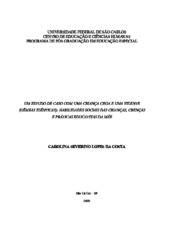| dc.contributor.author | Costa, Carolina Severino Lopes da | |
| dc.date.accessioned | 2016-06-02T19:46:32Z | |
| dc.date.available | 2005-05-30 | |
| dc.date.available | 2016-06-02T19:46:32Z | |
| dc.date.issued | 2005-02-28 | |
| dc.identifier.citation | COSTA, Carolina Severino Lopes da. A study of case with one blind and one sighted child (identicals twins: children s social skills, mother s beliefs and educative pratices.. 2005. 105 f. Dissertação (Mestrado em Ciências Humanas) - Universidade Federal de São Carlos, São Carlos, 2005. | por |
| dc.identifier.uri | https://repositorio.ufscar.br/handle/ufscar/3185 | |
| dc.description.abstract | The repertoire of social skills of blind and sighted children can be different from each other, inasmuch as the absence of the sense of sight prevents the blind children from using the same resources as those commonly used by the sighted ones, for example the visual imitation in the process of learning social skills and behaviors. The area of Social Skills Training (SST) was the theoretical and practical reference for this study, whose general aim was to describe and characterize the social performances of two identical twins aged ten years old: Célia, who is blind; and Virna, who is sighted. In addition, the beliefs and educational practices of their mother, who is their main caregiver, were identified. The data were obtained by conducting an interview with the mother as well as by filming the children during free situations. A transcript was made of the mother s answers to the questions from the interview script, and then the content was analyzed by theme. According to a protocol for observing the free situations, the films were assessed so that the children s performances enabled to infer the categories of social skills. The results showed that the mother considers that Virna is more independent to perform certain activities, while Célia requires more care and attention, besides being more subject to restrictions. The results also showed that the sighted child presented a wider and more refined repertoire of social skills in relation to her sister. From the data, it is possible to conclude that blind and sighted children have distinct social skills repertories, and the existing differences can be related to the blind variable as well as to the differences in the way the caretaker stimulates the children. Therefore, it is considered important to plan programs aiming to maximize the social development of visually impaired children, including social skills training and advices for the caregivers. | eng |
| dc.description.sponsorship | Financiadora de Estudos e Projetos | |
| dc.format | application/pdf | por |
| dc.language | por | por |
| dc.publisher | Universidade Federal de São Carlos | por |
| dc.rights | Acesso Aberto | por |
| dc.subject | Educação especial estudantes cegos | por |
| dc.subject | Habilidades sociais - avaliação e intervenção | por |
| dc.subject | Gêmeas idênticas | por |
| dc.subject | Práticas educativas | por |
| dc.subject | Visual Impairment | eng |
| dc.subject | Social skills | eng |
| dc.subject | Identical twins | eng |
| dc.subject | Mother s educative pratices and beliefs | eng |
| dc.title | Um estudo de caso com uma criança cega e uma vidente (gêmeas idênticas): habilidades sociais das crianças, crenças e práticas educativas da mãe | por |
| dc.title.alternative | A study of case with one blind and one sighted child (identicals twins: children s social skills, mother s beliefs and educative pratices. | eng |
| dc.type | Dissertação | por |
| dc.contributor.advisor1 | Del Prette, Almir | |
| dc.contributor.advisor1Lattes | http://lattes.cnpq.br/2191226494887247 | por |
| dc.description.resumo | O repertório de habilidades sociais de crianças cegas e videntes pode ser diferente, uma vez que a ausência do sentido da visão impede que as crianças cegas utilizem recursos comumente utilizados pelas crianças videntes, como, por exemplo, a imitação visual durante o processo de aprendizagem de habilidades e comportamentos sociais. A área do Treinamento de Habilidades Sociais (THS) foi a referência teórica e prática do presente estudo, cujo objetivo geral foi o de descrever e caracterizar o desempenho social de duas crianças, gêmeas idênticas, com dez anos de idade: Célia, que é cega; e Virna, que é vidente. Além disso, foram identificadas as crenças e práticas educativas da mãe, principal cuidadora dessas crianças. Os dados foram obtidos por meio da realização de uma entrevista com a mãe, bem como por meio de filmagens das crianças em situações livres. As respostas da mãe referentes às questões do roteiro de entrevista foram transcritas, procedendo-se, então, uma análise de conteúdo por tema. A filmagem foi avaliada de acordo com um protocolo de observação das situações livres, de modo que os desempenhos das crianças possibilitaram inferir as classes de habilidades sociais. Os resultados mostraram que a mãe considera que Virna é mais independente ao desempenhar determinadas atividades, enquanto que Célia requer maior número de cuidados, além estar sujeita a um número maior de restrições. Os resultados mostraram, ainda, que a criança vidente apresentou repertório de habilidades sociais mais amplo e refinado do que o de sua irmã. Com base nos dados, é possível concluir que crianças cegas e videntes possuem repertórios de habilidades sociais distintos, sendo que as diferenças existentes podem estar relacionadas tanto à variável cegueira quanto às diferenças na maneira como a cuidadora estimula as crianças. Dessa forma, considera-se indicado o planejamento de programas que visem maximizar o desenvolvimento social de crianças deficientes visuais, incluindo os de treinamento das habilidades sociais e de orientação para pais. | por |
| dc.publisher.country | BR | por |
| dc.publisher.initials | UFSCar | por |
| dc.publisher.program | Programa de Pós-Graduação em Educação Especial - PPGEEs | por |
| dc.subject.cnpq | CIENCIAS HUMANAS::EDUCACAO::TOPICOS ESPECIFICOS DE EDUCACAO::EDUCACAO ESPECIAL | por |
